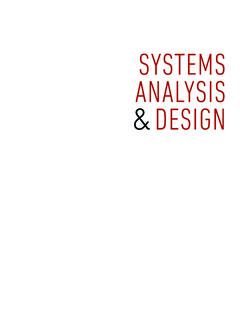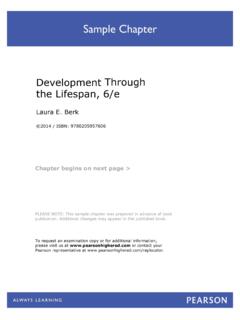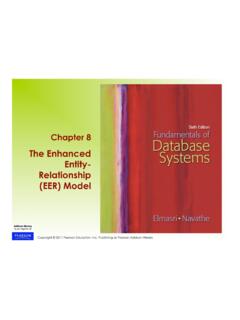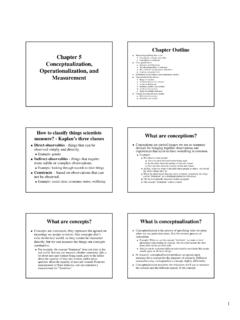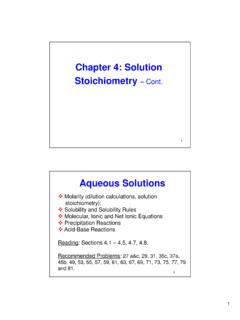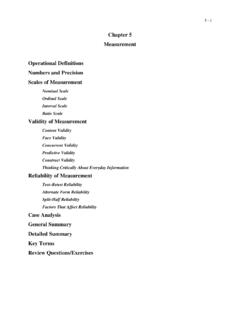Transcription of the Muscular System - Pearson
1 Learning OutcOmesAt the completion of your journey through this chapter , you will be able to: Differentiate the three major muscle types. Explain the difference between voluntary and involuntary muscles. Explain the types of skeletal muscle movement and the relationship between muscles. Review movement terminology. Identify and explain the components of a muscle cell. Describe the cellular activities required for muscle movement. Discuss how muscles receive the fuel they need to function. Identify specific skeletal muscles in different body regions. Define function and location of visceral or smooth muscle. Describe the function and actions of cardiac muscle. Name common disorders of the musculoskeletal for the Journeyas we continue our journey of exploration, we obviously need a transportation method so that we may reach our destination.
2 We can go by plane, train, or car. However, no matter what transportation System we use, we must utilize the body s Muscular System to get to the vehicle. Although the skeletal System provides the framework for the human body, the body also needs a System that allows move-ment, or locomotion, which is the job of the Muscular System . The movement we are most familiar with is the use of our external muscles to walk, run, or lift objects. This external movement allows us to explore all the wonderful sites throughout our journey and, yes, even to turn the pages as we journey through this book. However, movement is also required within the body. This internal movement occurs when food, air, waste products, and body fluids such as blood must all be transported within our bodies. For example, if you drink some bad water on your journey, the smooth muscles in your digestive tract will rapidly pass it through your System to be expelled in the form of urgent diarrhea.
3 Different types of spe-cialized muscles within the Muscular System allow for both external and internal movement. This chapter defines and contrasts the different muscle types needed for both external and internal body Muscular 12514/11/14 3:41 pm126 chapter 7skeletal muscles are voluntary muscles, which means they are under conscious control and derive their name because they are attached to the skeleton. The fibers in skeletal muscles appear to be striped and are therefore called striated (striped) muscle. These muscles allow us to perform external movements running, lifting, or scratching, for example. These are the muscles we try to develop through exercise and sports and also so we look good at the of the Muscular SySteMBecause of the numerous functions they must perform, muscles come in many shapes and sizes.
4 The structure of the muscle matches its function, as you will see of musclesmuscle is a general term for all contractile tissue. The term muscle comes from the Latin word mus, which means mouse, because the movement of muscles looks like mice running around under our skin. The contractile property of muscle tissue allows it to become short and thick in response to a nerve impulse. Muscles then relax back to their origi-nal length once that impulse is removed. When contracting, the muscles do not simply shorten, but exert a force as they become shorter. This alternate contraction and relaxation is what causes movement. Muscle cells are elongated and resemble strands of metal such as those found in cables. Mus-cle tissue is constructed of bundles of these strands that are referred to as muscle fibers.
5 These fibers are approximately the diameter of human hair. Under the direction of the nervous System , all the muscles provide for motion of some type for your body has three major types of muscles: skeletal, smooth, and cardiac. We begin with a general description and comparison of these three muscle types and then get more specific about each nun ci a tionDefinitions/Partsacetylcholine (ah SEET ul KOH leen)actin (ak TIN)adenosine triphosphate (ah DEN oh sin try FOSS fate)aponeurosis (APP oh new ROH sis)ataxia (ah TAK see uh)atrophy (AT roh fee)biceps brachii (BRA key eye)diaphragm (DYE ah fram)electromyography (ee LEK troh my OG rah fee)fibromyalgia (FIE broh my AL jee uh)flaccid (FLAS sid)flexion (FLEK shun)glycogen (GLIE koh jen)guillain-Barr syndrome (GEY yan bar RAY)hypertrophy (high PER troh fee)intercalated discs (in TER kuh LATE ed) Muscular dystrophy (MUS kyoo lahr DIS troh fee)myalgia (my AL jee uh)myasthenia gravis (my as THEE nee uh GRAV iss)myofibril (my oh FIE bril)myosin (MY oh sin)
6 Rigor mortis (RIG or MORE tiss)sarcomeres (SAR koh meerz)sphincter (SFING ter)tetanus (TET ah nus)tonus (TONE us)Pronunciation GuideCorrect pronunciation is important in any journey so that you and others are completely understood. Here is a see and say Pronunciation Guide for the more difficult terms to pronounce in this chapter . Please note that even though there are standard pronunciations, regional variations of the pronunciations can Factsmuscles Muscles make up almost half the weight of the body. there are 650 different muscles in the human body. the size of your muscles is influenced by how much you use them. this is why speed skaters have large leg muscles. Individual elongated muscle cells can be up to 12 inches, or 30 centimeters, in length. at about the age of 40, the number and diameter of muscle fibers begin to decrease, and by age 80, up to 50 percent of the muscle mass may be lost.
7 Exercise and good nutrition help to minimize this 12614/11/14 3:41 pmthe Muscular System : Movement for the Journey 127internal movement (circulation) of blood within the body. Fortunately, cardiac muscle, like smooth muscle, is an invol-untary muscle. Imagine if we had to think each time for our heart to muscles share certain characteristics such as the abil-ity to stretch, called extensibility. For example, if you would swallow a large bolus of food, the smooth muscle in your esophagus must be able to stretch and allow it to pass or it would become painfully stuck. In addition they all share contractility, which is the ability to contract or shorten mus-cle fibers forcefully. All muscles exhibit excitability, which is muscle response to stimulation by either nerves or hormones. Finally, all muscles show some level of elasticity, which is the ability to return to original resting length after being stretched.
8 Figure 7 1 contrasts the three types of muscles found within the body. We will now explore each of these types in further skeletal muscle, smooth muscle is involuntary and not under our conscious control. It is also called smooth muscle because it does not have the striped appearance of skeletal muscles. This involuntary muscle is found within certain organs, blood vessels, and airways. Because it is the muscle of organs, it is sometimes called visceral muscle. Smooth muscle allows for the internal movement of food (peristalsis) in the case of the stomach and other digestive organs. In addition, smooth muscle facilitates the movement of blood by changing the diameter of the blood vessels (vasoconstriction and vasodilation) and also the movement of air by changing the diameter of the airways found in our third type of muscle is the specialized cardiac mus-cle, which is striated like skeletal muscle.
9 This muscle type is found solely in the heart. It makes up the walls of the heart and causes it to contract. These contractions cause the Figure 7 1 the three types of muscle: Skeletal, cardiac, and muscleMusclefiberMyofibrilCardiac muscleMicrograph ofcardiac muscleSmooth muscleThese voluntary musclesare attached to bones andare characterized by being long and cylindrical and havea pronounced striatedappearance. This involuntary muscleis found in the walls of theheart. These lightly striated muscles functionmore efficiently through the use of intercalated involuntary muscle type is found in the walls of hollow organs and vessels as well as respiratory airways. These nonstriated musclescontract and relax and help performperistalsis and maintain the diameterof blood vessels and airways.
10 12714/11/14 3:41 pm128 chapter 7of connection is found, for example, in some facial and abdominal mentioned earlier, skeletal muscle is known as volun-tary muscle; this is because its movement can be controlled by conscious thought. The numerous skeletal muscles found throughout the body are responsible for movement, maintain-ing our body posture, and heat generation. Figure 7 2 shows some of the major skeletal muscles found in the human MuScleSSkeletal muscles are attached to bones and provide move-ment for your body. Remember from chapter 6, The Skel-etal System , that tendons are fibrous tissues that usually attach skeletal muscle to bones and that ligaments attach bone to bone? Note that some muscles can attach to a bone or soft tissue without a tendon. Such muscles use broad sheets of connective tissue called aponeuroses.






